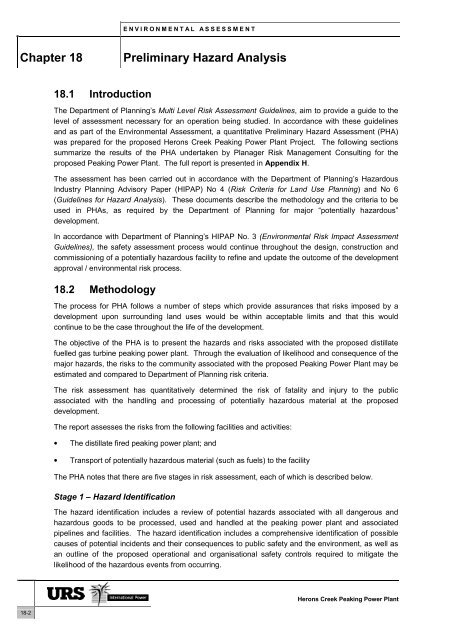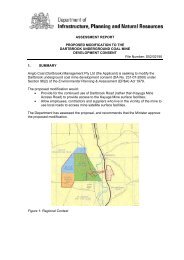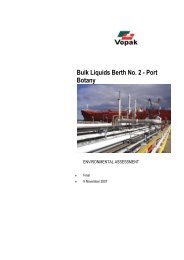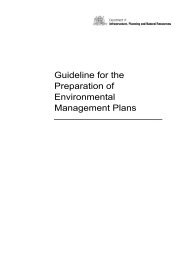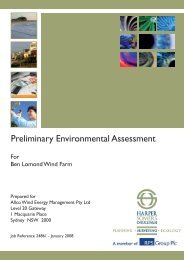Preliminary Hazard Analysis - Department of Planning
Preliminary Hazard Analysis - Department of Planning
Preliminary Hazard Analysis - Department of Planning
Create successful ePaper yourself
Turn your PDF publications into a flip-book with our unique Google optimized e-Paper software.
E N V I R O N M E N T A L A S S E S S M E N T<br />
Chapter 18<br />
<strong>Preliminary</strong> <strong>Hazard</strong> <strong>Analysis</strong><br />
18.1 Introduction<br />
The <strong>Department</strong> <strong>of</strong> <strong>Planning</strong>’s Multi Level Risk Assessment Guidelines, aim to provide a guide to the<br />
level <strong>of</strong> assessment necessary for an operation being studied. In accordance with these guidelines<br />
and as part <strong>of</strong> the Environmental Assessment, a quantitative <strong>Preliminary</strong> <strong>Hazard</strong> Assessment (PHA)<br />
was prepared for the proposed Herons Creek Peaking Power Plant Project. The following sections<br />
summarize the results <strong>of</strong> the PHA undertaken by Planager Risk Management Consulting for the<br />
proposed Peaking Power Plant. The full report is presented in Appendix H.<br />
The assessment has been carried out in accordance with the <strong>Department</strong> <strong>of</strong> <strong>Planning</strong>’s <strong>Hazard</strong>ous<br />
Industry <strong>Planning</strong> Advisory Paper (HIPAP) No 4 (Risk Criteria for Land Use <strong>Planning</strong>) and No 6<br />
(Guidelines for <strong>Hazard</strong> <strong>Analysis</strong>). These documents describe the methodology and the criteria to be<br />
used in PHAs, as required by the <strong>Department</strong> <strong>of</strong> <strong>Planning</strong> for major “potentially hazardous”<br />
development.<br />
In accordance with <strong>Department</strong> <strong>of</strong> <strong>Planning</strong>’s HIPAP No. 3 (Environmental Risk Impact Assessment<br />
Guidelines), the safety assessment process would continue throughout the design, construction and<br />
commissioning <strong>of</strong> a potentially hazardous facility to refine and update the outcome <strong>of</strong> the development<br />
approval / environmental risk process.<br />
18.2 Methodology<br />
The process for PHA follows a number <strong>of</strong> steps which provide assurances that risks imposed by a<br />
development upon surrounding land uses would be within acceptable limits and that this would<br />
continue to be the case throughout the life <strong>of</strong> the development.<br />
The objective <strong>of</strong> the PHA is to present the hazards and risks associated with the proposed distillate<br />
fuelled gas turbine peaking power plant. Through the evaluation <strong>of</strong> likelihood and consequence <strong>of</strong> the<br />
major hazards, the risks to the community associated with the proposed Peaking Power Plant may be<br />
estimated and compared to <strong>Department</strong> <strong>of</strong> <strong>Planning</strong> risk criteria.<br />
The risk assessment has quantitatively determined the risk <strong>of</strong> fatality and injury to the public<br />
associated with the handling and processing <strong>of</strong> potentially hazardous material at the proposed<br />
development.<br />
The report assesses the risks from the following facilities and activities:<br />
• The distillate fired peaking power plant; and<br />
• Transport <strong>of</strong> potentially hazardous material (such as fuels) to the facility<br />
The PHA notes that there are five stages in risk assessment, each <strong>of</strong> which is described below.<br />
Stage 1 – <strong>Hazard</strong> Identification<br />
The hazard identification includes a review <strong>of</strong> potential hazards associated with all dangerous and<br />
hazardous goods to be processed, used and handled at the peaking power plant and associated<br />
pipelines and facilities. The hazard identification includes a comprehensive identification <strong>of</strong> possible<br />
causes <strong>of</strong> potential incidents and their consequences to public safety and the environment, as well as<br />
an outline <strong>of</strong> the proposed operational and organisational safety controls required to mitigate the<br />
likelihood <strong>of</strong> the hazardous events from occurring.<br />
Herons Creek Peaking Power Plant<br />
18-2


